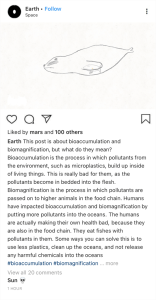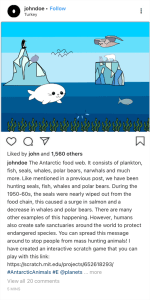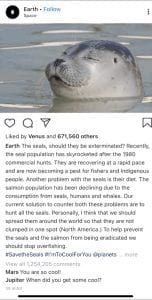Hello people! Welcome to my first blog post!
Our first sector in science is finally over. The driving question for this sector was: In what ways has humans impacted the delicate cycles within our local ecosystem and how can we lessen the impact?
To answer this question, we learned about the different ecosystems that are around us and how we have impacted them. On the first lesson, we learned about the different types of ecosystems and abiotic/biotic factors that resides in the ecosystems. The activity we did for this lesson was to draw an ecosystem with 5 abiotic and biotic factors in it.
Then there was the earth’s spheres. There are five spheres in the earth. The most commonly know is the atmosphere (air). The other four are the hydrosphere (water), geosphere (minerals, rocks, etc), biosphere (all life), and cryosphere (ice). The first activity that we did was to identify five objects by:
- classify them as abiotic or biotic.
- identify which sphere they belong to.
- brainstorm ways in which they interact with each of the spheres of the Earth
Our second work for this one is to look at the image of the Sydney Opera House taken by our teacher Ms. Kadi and consider ways in which us human have impacted the biosphere, hydrosphere, and atmosphere.
After this we were introduced to our first keystone, which was a scratch project on the food web. We had to make an interactive food web on Scratch. We had to next few days to think about which ecosystem’s food web we wanted to do and our design.
During those few days, we did a activity where we had to come up with a solution to prevent fiber plastics that came from our clothes from getting into the oceans. When our clothes get washed, these little fiber plastics goes from the washing machines and into the oceans. We were once again put in groups and my group came up with a filter system. It had two layers of filter that can be installed in any washing machines’ drains.
Then we learned about bioaccumulation and biomagnification. Bioaccumulation is the process in which pollutants from the environment, such as microplastics, build up in living things over time. Biomagnification is where the amount of pollutant in a living organism becomes grows bigger as you move up the food chain. Our activity for this lesson was to create a GIF showing the process of biomagnification. Here it is:Biomagnification GIF
For the next few days that we had until our field study, we worked on our Scratch project and it had to be completed before we went. Here were our instructions and criteria:
We will be picking an ecosystem of your choice, selecting a minimum of 10 living things, and illustrating the many ways the living things interact with each other. It is suggested that we complete this activity on Scratch.
Our food web must:
- Display an ecosystem of your choice
2. Have a minimum of 10 living things, both plants and animals
3. The plants and animals you choose, as well as their interactions, must be realistic for your chosen ecosystem.
4. State how the living things interact with each other.
5. Be visually pleasing.
We will then be write a short reflection, from 5-7 sentences, answering the following question: “Consider your food web. What are ways in which human beings have impacted it? How does your food web illustrate the interconnectedness and interdependence of ecosystems?”
For those of you who doesn’t know what Scratch is, it’s a coding software. I have had experience with coding in the past, so this keystone wasn’t really hard for me. In my food web, I chose an ocean ecosystem and added a little game to it. I enjoyed doing this project because I like coding and making games. Click here if you want to check it out.
After the field study, we learned about wildlife management and how some animals are overpopulating and how some are endangered. Then we make our second keystone. For this one, we got into groups and made a video. The video was like a news report. We were separated into groups of 3-4 and given an animal to talk about. My group, consisted of Daniel, Tom, and Frankie, was given the caribou. We read several sources on the caribou’s decline in their population and how the government chose to kill the wolfs that are hunting them. After several years, some people realized that this method wasn’t working, so they tried to tell the government, but the government didn’t listen.
In our video, we had to talk about the caribou’s decline, hunting to wolves in order to try to stop the decline, how that didn’t work, and we had to come up with a new way to try to stop the decline. My group learned that deforestation plays a major part in the decline, so our idea to stop it was to stop deforestation. Our video is kind of chaotic and hard to follow, but we made it funny. It includes some memes, so you should see it.
Also, check out my teammates’ blogs!
Before our third keystone, we had just one more thing to learn, and that is the nutrient cycles and how we have impacted it. We learned what a nutrient cycle is and the three types of nutrient cycle: carbon, nitrogen, and phosphorus. We also learned the short-term and long-term storages, and movements for each cycle. Our activity for this one was creating a poster that explained how humans have impacted one of the three cycles.
For our third and final keystone, we had to make fake instagram posts on a fake instagram post generator. Each of our social media posts addressed a different problem, as well as a proposed way of reducing the impact. We had 5 social media posts on the following topics:
- The Earth’s spheres, and human impacts on each of them
- Bioaccumulation, biomagnification, and how humans impacted them
- Local food web and how humans impacted them
- Local wildlife management practices and how humans impacted them
- Nutrient cycles and how humans impacted them
At the end of this sector, I realized that there are many bad things that humans have done to this planet and the ecosystems that resides within it. There are some choices made that are not really good, and we have done barely anything to help solve these problems. The negative impacts that we put out are also impacting us, and if we don’t do anything to stop these impacts, then who will?





